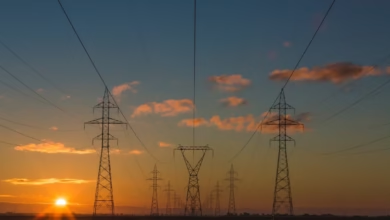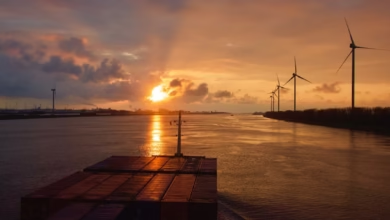Navigating Global Energy Trade: Trends in Exports, Imports, and the Transition to Renewable Sources

In an era marked by climate change and rapid technological advancements, the global trade of energy resources has never been more crucial. The dynamics of energy exports and imports are evolving as nations seek to balance their energy needs with sustainability goals. This article delves into the complex landscape of energy markets, highlighting key trends in energy exports and imports, the pivotal role of renewable energy alongside fossil fuels, and the policies shaping energy security in a changing climate. As we navigate the energy transition, understanding the interplay between various energy sources—such as solar power, wind energy, nuclear energy, and thermal energy—is essential. Furthermore, innovations in energy storage, carbon capture, and smart grids are transforming how energy is produced, transported, and consumed. By examining these elements, we aim to provide insights into the emerging global energy trends and the investments necessary for a sustainable energy future. Join us as we explore the multifaceted world of energy economics, energy efficiency, and the policies that will define our energy landscape in the coming years.
- 1. The Global Energy Landscape: Trends in Energy Exports and Imports
- 2. Navigating the Energy Transition: The Role of Renewable Energy and Fossil Fuels
- 3. Energy Markets and Policy: Ensuring Energy Security in a Changing Climate
1. The Global Energy Landscape: Trends in Energy Exports and Imports
The global energy landscape has undergone significant transformations in recent years, driven by a combination of policy shifts, technological advancements, and evolving market dynamics. As countries strive to meet their energy needs while addressing climate change, the trends in energy exports and imports reflect a broader energy transition toward more sustainable practices.
Fossil fuels, which have historically dominated the energy markets, are experiencing a gradual decline in demand, particularly in developed nations. This shift is evident as investments in renewable energy sources such as solar power, wind energy, and hydropower surge. Renewable energy has become a cornerstone of many countries' energy policies, leading to a corresponding increase in energy exports from nations rich in these resources. For instance, countries in the Middle East are increasingly looking to diversify their energy portfolios by investing in renewable technologies, enabling them to export both fossil fuels and green energy.
The rise of energy storage technologies has also played a crucial role in this transition. Enhanced energy efficiency and innovations in energy storage systems allow for better integration of intermittent renewable sources into national grids, promoting energy security and stability. Smart grids are becoming prevalent, enabling real-time energy management and the optimization of energy transportation. As a result, countries are better equipped to balance their energy imports and exports, ensuring a more resilient energy economy.
Nuclear energy remains a significant player in global energy markets, particularly in regions aiming for low-carbon energy solutions. With advancements in carbon capture and storage technology, nuclear power can complement renewable energy sources, further enhancing energy security and reducing greenhouse gas emissions. The commitment to energy innovation is evident in the growing interest in hydrogen energy and bioenergy, which are being explored as viable alternatives to traditional fossil fuels.
As the world transitions towards a more decentralized energy model, distributed energy systems are gaining traction. This shift facilitates local energy production and consumption, reducing reliance on energy imports and bolstering local economies. Electric vehicles are also contributing to this transformation, prompting countries to rethink their energy policies to accommodate a future that prioritizes renewable and cleaner energy sources.
In conclusion, the global trends in energy exports and imports indicate a profound shift towards sustainable energy solutions. As nations navigate the complexities of energy economics amidst climate change challenges, the focus on energy innovations and the adoption of green energy practices will shape the future of global energy markets. The continued investment in renewable energy, energy efficiency, and smart technology is essential for achieving a balanced and secure energy future.
2. Navigating the Energy Transition: The Role of Renewable Energy and Fossil Fuels
The energy transition is a pivotal shift in how the world sources and utilizes energy, moving from traditional fossil fuels to more sustainable options like renewable energy. This transition is not merely a change in energy sources; it encompasses a comprehensive transformation of energy markets, policies, and technologies that aim to enhance energy efficiency and reduce carbon emissions.
Renewable energy sources such as solar power, wind energy, hydropower, and bioenergy play a crucial role in this transition. These green energy solutions not only help mitigate climate change by lowering greenhouse gas emissions but also enhance energy security by diversifying energy supply options. As countries invest in renewable technologies, they can reduce their dependence on fossil fuels, which have been the backbone of global energy systems for decades.
However, the transition does not mean an immediate phase-out of fossil fuels. In many regions, fossil fuels continue to be integral to energy production and consumption. The challenge lies in implementing strategies such as carbon capture technologies that can help reduce the carbon footprint of existing fossil fuel infrastructure. Furthermore, nuclear energy also remains a significant player in the energy mix, providing a stable and low-carbon energy source that complements intermittent renewables.
To enable a successful energy transition, energy storage technologies become increasingly essential. Efficient energy storage solutions allow for better integration of renewable sources into the grid, addressing the challenge of their variable output. Smart grids and distributed energy systems facilitate the management of these resources, optimizing energy transportation and consumption across regions.
Investments in energy innovations and research and development (R&D) are vital for advancing technologies that enhance energy efficiency and reduce costs. For instance, hydrogen energy is gaining traction as a versatile energy carrier that can support both transportation and power generation, providing a bridge between fossil fuels and renewables.
As global energy trends evolve, energy policies must adapt to promote sustainable practices and investments. Governments and organizations are recognizing the importance of aligning energy investments with climate goals, fostering a greener economy that prioritizes renewable energy while managing the transition from fossil fuels. This careful navigation of the energy transition will shape the future of energy exports and imports, influencing international trade dynamics and energy economics.
In conclusion, the energy transition is a multifaceted process requiring collaboration among various energy resources, innovative technologies, and forward-thinking policies. The balance between renewable energy and fossil fuels, along with advancements in energy storage and efficiency, is crucial for achieving a sustainable energy future while addressing the pressing challenges of climate change.
3. Energy Markets and Policy: Ensuring Energy Security in a Changing Climate
In today's rapidly evolving landscape, energy markets and policy play a crucial role in ensuring energy security, especially in the face of climate change. As nations strive to balance their energy imports and exports, they are increasingly turning to diverse energy sources, including renewable energy, fossil fuels, and nuclear energy. The shift towards a low-carbon economy necessitates a robust energy policy that promotes energy efficiency and sustainability while addressing the challenges posed by global energy trends.
The energy transition is a key focus for policymakers worldwide. By investing in green energy solutions such as solar power, wind energy, and hydropower, countries can reduce their reliance on fossil fuels and enhance energy security. Furthermore, innovations in energy storage and smart grids are vital for effective energy transportation and distribution, enabling the integration of distributed energy resources into the grid. For instance, energy storage technologies allow for better management of intermittent renewable energy sources, ensuring a stable supply even when production fluctuates.
Additionally, the role of energy investment cannot be understated. Governments and private sectors are increasingly directing funds towards energy R&D, focusing on advancements like carbon capture technologies and hydrogen energy. These innovations not only support the reduction of greenhouse gas emissions but also position countries to strengthen their energy markets. By diversifying their energy portfolios and promoting energy exports, nations can enhance their energy security while contributing to the global fight against climate change.
In conclusion, as the world grapples with the impacts of climate change, energy markets and policies must adapt to ensure a secure and sustainable energy future. Emphasizing energy efficiency, renewable energy, and innovative technologies will be essential for creating resilient energy systems that meet the needs of a changing climate. By prioritizing these strategies, countries can navigate the complexities of energy imports and exports while fostering a more sustainable energy landscape.
In conclusion, the global trade of energy resources is undergoing a significant transformation as countries navigate the complexities of the energy transition. With trends indicating a shift towards renewable energy sources such as solar power, wind energy, hydropower, and bioenergy, the landscape of energy exports and imports is evolving. The integration of fossil fuels and nuclear energy remains crucial, but the emphasis is increasingly on enhancing energy efficiency and promoting green energy initiatives.
As energy markets adapt to new policies aimed at ensuring energy security in the face of climate change, innovations such as carbon capture, smart grids, and energy storage solutions are becoming vital. These advancements not only enhance energy transportation but also facilitate a more distributed energy model that empowers local communities and businesses.
Investment in diverse energy sources, including thermal energy and emerging technologies like hydrogen energy and electric vehicles, is essential for fostering a resilient energy economy. As nations collaborate on energy R&D, the collective efforts towards achieving a sustainable energy future will shape global energy trends for decades to come. By embracing these changes and prioritizing energy security, we can work towards a balanced and efficient energy system that meets the needs of our planet and its inhabitants.
References:
(Ensure to include a list of sources used in the article here)





